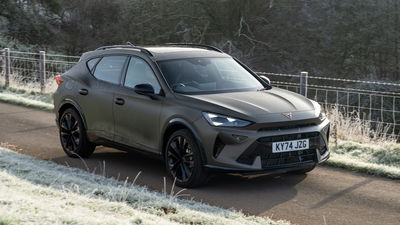Mini Countryman SE Review: Quick, But Not All That Fun

Pros
- Fun, high-quality and spacious interiorProperly quick off the line
Cons
- Not the most involving EV to driveFrustrating infotainment system
You have to feel a bit sorry for the Mini Countryman. BMW’s earnest attempt to grow the Mini brand into more profit-friendly market segments has led to it spending the last 14 years as the butt of countless unimaginative “not exactly Mini, is it?” or “they should have called it the Maxi, huh-huh” jibes from – let’s be honest here – crashing bores.
That hasn’t stopped it being a success, mind. It’s the only model to have survived from Mini’s ultimately overambitious 2010s range expansion that also gave us the cool-in-concept, flawed-in-execution Roadster and Coupe, the slightly gawky Clubman, and the utterly inexplicable Paceman.
It lives on as the largest member of what’s currently a two-model Mini range, although it’ll soon be joined by the bigger-than-Cooper, smaller-than-Countryman Aceman.

It entered its third generation last year, and for the first time comes with the choice of petrol and full electric power. It’s based on a revised version of the same underpinnings as the old model and is basically identical underneath to the new BMW X1 and X2.
You wouldn’t know that from looking at it, though. The Countryman’s always tried to transpose Mini styling cues onto a larger body, with varying degrees of success. To our eyes though, the third-gen car is the least cohesive. Ironically for a company that’s coined its new design language ‘Charismatic Simplicity’, there’s rather a lot going on, and not much of it works harmoniously.

Things are better inside, where the new Cooper’s interior stylings are translated much more successfully. There’s the same focus on high-quality and sustainable materials, and most of it feels very high-end. You get the same funky textile dash on certain trims, and the emphasis on fun design is even more welcome on what’s otherwise a fairly strait-laced crossover.
This family commonality has its downsides, though, namely the 9.45-inch circular infotainment screen. Yes, it looks neat and yes, its shape nods to Mini’s heritage, but it’s also a frustratingly busy, unintuitive mess to navigate. At least you still get proper controls for audio and phone connectivity.
These are otherwise largely pleasant surroundings, though. It’s comfy, there’s plenty of room, and visibility is good all-round thanks to the glassy, upright greenhouse.

In electric form, the Countryman comes in two versions, both powered by a 64.7kWh battery. The bottom rung, the Countryman E, uses a single 201bhp motor to power the front wheels. The one we’ve been driving, though, is the SE All4, a dual-motor, all-wheel drive setup that kicks out an impressive 309bhp and 364lb ft of torque.
Range is a quoted 269 miles, dropping from 287 miles on the single-motor car, and pretty much on the money for a mid-size, dual-motor family EV like this. In the real world, expect a figure lower in the mid-200s. Find a rapid charger, and you can top it up from 10 to 80 per cent in under half an hour, according to Mini.

Unsurprisingly, that power makes the Countryman SE a properly quick car. 62mph is dealt with in 5.6 seconds, although the usual EV top speed caveat applies, as it runs out of puff at 111mph. At normal road speeds, though, you’re never left wanting for pace, especially when you pull the paddle behind the wheel to activate Boost Mode.
This is a feature Mini’s kept oddly quiet about, but it effectively activates all the spiciest powertrain settings for up to 10 seconds. It’s very handy for overtaking and makes the Countryman really surge forward. Despite this power, though, it never feels skittery or nervous thanks to its four-wheel drive.

Unfortunately, it never feels particularly exciting either. Once the initial surprise of its acceleration wears off, the Countryman SE’s quite a numb thing to drive overall. Mini may roll out the same line about go-kart handling as it does for the Cooper SE, but the reality is that the steering and brakes respond with nothing like the immediacy or delicacy of its little sibling.
Where the Cooper SE feels like a Mini that just happens to be electric, the Countryman feels like exactly what it is – a reasonably large, reasonably powerful family EV. Fine, really, for the purpose it's meant to serve, but you kind of expect a little more from an S-badged Mini. The fact it weighs in at just over two tonnes may have something to do with this. Maybe those crashing bores are right.

The flipside to this slightly uninvolving drive is a ride that’s largely comfy and cosseting. This will perhaps come as a shock to anyone who’s driven other S-badged Minis, including the choppy new electric Cooper. Here, that badge is best thought of as one that just offers some extra power rather than a more overtly sporty drive.
The electric family crossover class is a crowded one, and the Countryman SE occupies a middle ground within it. It’s sandwiched between mass-market cars like the Volkswagen ID.4, Ford Explorer and Kia EV3, and ‘premium’ stuff like the Audi Q4 e-tron, Volvo EX40 and its own platform-mate, the BMW iX1.

Its price reflects that, starting at £47,180 for the SE. It’s quite a chunk for a car whose biggest selling point over rivals is its funky interior. If that does sway you, then you have to ask yourself: do you really need the extra power offered by the SE? The 201bhp Countryman E gets a better range and starts at a full £5,100 less.
You’re sacrificing quite a lot of pace, with the 0-62mph time dropping from 5.6 to 8.6 seconds, but that shouldn’t really be an issue in something that’s most likely to be bought as a family car. As is so often the case with mainstream EVs, the most expensive, fastest version isn’t necessarily the best.















Comments
No comments found.